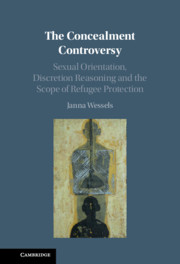 The Concealment Controversy
The Concealment Controversy Particular Social Group and the Limits of Protection
from Part II - Exploring the Limits of Protection
Published online by Cambridge University Press: 19 July 2021
Chapter 8 addresses the competing definitions of the Convention ground ‘particular social group’: the ‘protected characteristics’ approach and the ‘social perception' approach. Whereas both are capable of encompassing sexuality-based claims, they each hold the potential for ‘discretion’ reasoning in different ways. The ‘protected characteristics’ approach is designed to exclude ‘trivial’ claims. If claimants fear harm for what is considered a non-fundamental aspect, they can be returned to be ‘discreet’. The ‘social perception’ test in contrast, which would more appropriately be called the ‘persecutor’s perception’ approach, in principle precludes any a priori exclusion of certain particular social groups. In this approach, it is the persecutor who defines what is persecuted. Yet the chapter shows that even this broader approach is prone to ‘discretion’ logics: the limit that is reverted to is the ‘singling out’ requirement, providing protection only to those who are singled out for persecution whereas those deemed able to pass unnoticed can be returned. As such, in both approaches, the protected group is not the same as the persecuted group, such that those who are persecuted but not protected must remain ‘discreet’.
To save this book to your Kindle, first ensure [email protected] is added to your Approved Personal Document E-mail List under your Personal Document Settings on the Manage Your Content and Devices page of your Amazon account. Then enter the ‘name’ part of your Kindle email address below. Find out more about saving to your Kindle.
Note you can select to save to either the @free.kindle.com or @kindle.com variations. ‘@free.kindle.com’ emails are free but can only be saved to your device when it is connected to wi-fi. ‘@kindle.com’ emails can be delivered even when you are not connected to wi-fi, but note that service fees apply.
Find out more about the Kindle Personal Document Service.
To save content items to your account, please confirm that you agree to abide by our usage policies. If this is the first time you use this feature, you will be asked to authorise Cambridge Core to connect with your account. Find out more about saving content to Dropbox.
To save content items to your account, please confirm that you agree to abide by our usage policies. If this is the first time you use this feature, you will be asked to authorise Cambridge Core to connect with your account. Find out more about saving content to Google Drive.